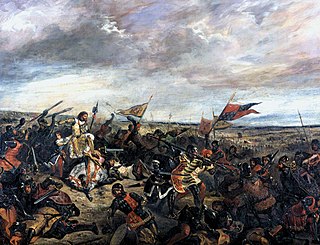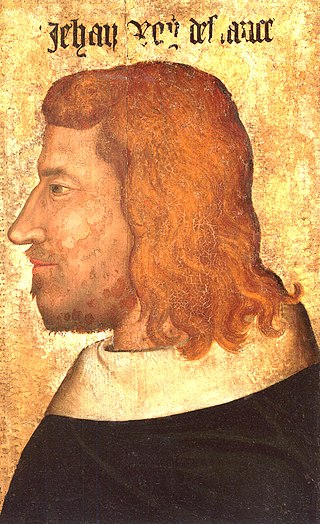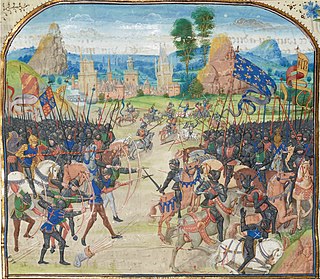Sir Eustace de Ribemont (died 19 September 1356) was a French nobleman, who was the French standard-bearer in 1346.
Sir Eustace de Ribemont (died 19 September 1356) was a French nobleman, who was the French standard-bearer in 1346.
Eustace was lord of Ribemont in Tierasche, Picardy. He fought in the Hundred Years' War, where he fought during the battle of Calais in 1350. The French knight Geoffroi de Charny, bribed Amerigo de Pavia of the Calais garrison to open a gate for the French forces. [1] Ribemont was engaged in combat by King Edward III of England, who fought incognito, whom Ribemont knocked down a couple of times during the fight and was later captured. He was later released without ransom for his bravery.
He was the French standard-bearer at the battle of Poitiers on 19 September 1356, where he was killed. [2]

The Battle of Poitiers was fought on 19 September 1356 between a French army commanded by King John II and an Anglo-Gascon force under Edward, the Black Prince, during the Hundred Years' War. It took place in western France, 5 miles (8 km) south of Poitiers, when approximately 14,000 to 16,000 French attacked a strong defensive position held by 6,000 Anglo-Gascons.

John II, called John the Good, was King of France from 1350 until his death in 1364. When he came to power, France faced several disasters: the Black Death, which killed nearly one-third to one-half of its population; popular revolts known as Jacqueries; free companies of routiers who plundered the country; and English aggression that resulted in catastrophic military losses, including the Battle of Poitiers of 1356, in which John was captured.

The Oriflamme, a pointed, blood-red banner flown from a gilded lance, was the sacred battle standard of the King of France and a symbol of divine intervention on the battlefield from God and Saint Denis in the Middle Ages. The oriflamme originated as the sacred banner of the Abbey of St. Denis, a monastery near Paris. When the oriflamme was raised in battle by the French royalty during the Middle Ages, most notably during the Hundred Years' War, no prisoners were to be taken until it was lowered. Through that tactic, they hoped to strike fear into the hearts of the enemy, especially the nobles, who could usually expect to be taken alive for ransom during such military encounters.

Admiral of the Fleet John Paveley de Beauchamp, 1st Baron Beauchamp de Warwick KG was the third son of Guy de Beauchamp, 10th Earl of Warwick, and brother of Thomas de Beauchamp, 11th Earl of Warwick, with whom he became a founder and the tenth Knight of the Order of the Garter in 1348.

Yuval Noah Harari is an Israeli medievalist, military historian, public intellectual, and writer. He currently serves as professor in the Department of History at the Hebrew University of Jerusalem. He is the author of the popular science bestsellers Sapiens: A Brief History of Humankind (2011), Homo Deus: A Brief History of Tomorrow (2016), and 21 Lessons for the 21st Century (2018). His writings examine free will, consciousness, intelligence, happiness, and suffering.

The Battle of Calais took place in 1350 when an English force defeated an unsuspecting French army which was attempting to take the city. Despite a truce being in effect the French commander Geoffrey de Charny had planned to take the city by subterfuge, and bribed Amerigo of Pavia, an Italian officer of the city garrison, to open a gate for them. The English king, Edward III, became aware of the plot and personally led his household knights and the Calais garrison in a surprise counter-attack. The French were routed by this smaller force, with significant losses and all their leaders captured or killed.

Sapiens: A Brief History of Humankind is a book by Yuval Noah Harari, first published in Hebrew in Israel in 2011 based on a series of lectures Harari taught at The Hebrew University of Jerusalem, and in English in 2014. The book, focusing on Homo sapiens, surveys the history of humankind, starting from the Stone Age and going up to the twenty-first century. The account is situated within a framework that intersects the natural sciences with the social sciences.

Homo Deus: A Brief History of Tomorrow is a book written by Israeli author Yuval Noah Harari, professor at the Hebrew University in Jerusalem. The book was first published in Hebrew in 2015 by Dvir publishing; the English-language version was published in September 2016 in the United Kingdom and in February 2017 in the United States.

The Crécy campaign was a series of large-scale raids (chevauchées) conducted by the Kingdom of England throughout northern France in 1346 that devastated the French countryside on a wide front, culminating in the Battle of Crécy. The campaign was part of the Hundred Years' War.

The Black Prince's chevauchée of 1356 was a large-scale mounted raid by an Anglo-Gascon force under the command of Edward, the Black Prince, between 4 August and 2 October 1356 as a part of the Hundred Years' War. The war had broken out in 1337, but a truce and the ravages of the Black Death had restricted the extent of the fighting since 1347. In 1355 the French king, John II, determined to resume full-scale war. That autumn, while Edward III of England threatened northern France, his son, Edward of Woodstock, later known as the Black Prince, carried out a devastating mounted raid, or chevauchée: an Anglo-Gascon army marched from the English possession of Gascony 675 miles (1,086 km) to Narbonne and back. The French refused battle, despite suffering enormous economic damage.

The Black Prince's chevauchée, also known as the grande chevauchée, was a large-scale mounted raid carried out by an Anglo-Gascon force under the command of Edward, the Black Prince, between 5 October and 2 December 1355 as a part of the Hundred Years' War. John, Count of Armagnac, who commanded the local French forces, avoided battle, and there was little fighting during the campaign.
Sir Oudart I de Renti, Lord of Embry, Curlu, Affringues, and Vaudringhem was a French nobleman.
Sir Pépin de Wierre, Lord of Maison-Ponthieu, was a French nobleman.
Lancaster's chevauchée of 1356 in Normandy was an English offensive directed by Henry, Duke of Lancaster, in northern France during 1356, as a part of the Hundred Years' War. The offensive took the form of a large mounted raid – a chevauchée – and lasted from 22 June to 13 July. During its final week the English were pursued by a much larger French army under King John II that failed to force them to battle.
The siege of Guînes took place from May to July 1352, when a French army under Geoffrey de Charny unsuccessfully attempted to recapture the French castle at Guînes which had been seized by the English the previous January. The siege was part of the Hundred Years' War and took place during the uneasy and oft-broken truce of Calais.
The Treaty of Guînes was a draft settlement to end the Hundred Years' War, negotiated between England and France and signed at Guînes on 6 April 1354. The war had broken out in 1337 and was further aggravated in 1340 when the English king, Edward III, claimed the French throne. The war went badly for France: the French army was heavily defeated at the Battle of Crécy, and the French town of Calais was besieged and captured. With both sides exhausted, a truce was agreed that, despite being only fitfully observed, was repeatedly renewed.

The siege of Breteuil was the investment of the Norman town of Breteuil, held by partisans of Charles II, King of Navarre, by French forces. It lasted from April to about 20 August 1356. It was interrupted on 5 July when a small English army commanded by Henry, Earl of Lancaster relieved and resupplied it. The French king, John II, attempted to bring Lancaster to battle with the much larger French royal army, but Lancaster marched away and the attempt failed. John then renewed the siege of Breteuil.
Eustace d'Aubrichecourt or d'Abrichecourt or d'Auberchicourt, of the Auberchicourt family, was a French knight who enlisted in the service of the English during the Hundred Years' War. His knightly exploits were recorded by Froissart.

English offensives in 1345–1347, during the Hundred Years' War, resulted in repeated defeats of the French, the loss or devastation of much French territory and the capture by the English of the port of Calais. The war had broken out in 1337 and flared up in 1340 when the king of England, Edward III, laid claim to the French crown and campaigned in northern France. There was then a lull in the major hostilities, although much small-scale fighting continued.